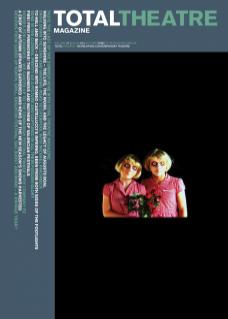The press launch for Brighton Festival saw ‘guest artistic director’ Anish Kapoor stating that he viewed the whole city as a potential site for art, so there were high hopes that despite the departure of certain key members of the Brighton team (including highly respected theatre programmer Jane McMorrow), we had a lot of good site-responsive work to look forward to. Sadly, those hopes were, for the most part, dashed.
Kapoor’s own out-of-the-gallery work consisted of previously existing pieces re-sited. Sky Mirror, placed in Pavilion Gardens, was too small for the space and fenced in to boot, which seemed to defeat the point of public art – it wasn’t long before it was being referred to locally as Kapoor’s shaving mirror. C-Curve (another mirror piece) fared better – but the same South Downs site had been previously used to far better effect by Red Earth, so this piece suffered in the comparison.
So what of the theatre and performance? The opening weekend saw Walk the Plank’s Fire, Smoke and Mirrors come to town. It’s a typical WTP walk-through fire garden piece – a whimsical and gentle collection of fiery sculptures and installations, including a very lovely tree of chandeliers and a lake lit with floating flames. Yet in a park with big open spaces the sense of discovery is for the most part lost. Worse, it was sold to the public as the big festival opening night show, so the park was teeming with families and groups of teenagers wondering when the fireworks were going to start. The worst sin was the inappropriate placing of the Sharmanka/ Fittings Multimedia Arts work Sputnik in the middle of all this – apart from the oddness of just bunging in another company’s work into the site, it was not even credited accordingly in the publicity.
Another garden piece was Alice in the Walled Garden, a promenade children’s music-theatre show. Although a pleasant enough experience, it was average work by a little-known company (directed by Jenny Lee). Had it been a Fringe show I’d have looked on it more favourably, but a show can only be judged in its context – and this show was not of the standard required for a major international festival. The management of the audience was lacking, and I was irritated by actors ‘offstage’ chatting to ushers.
Hubbert’s Peak was at least by a company of some renown (French street arts veterans Les Alama’s Givrés) and executed with professionalism and panache. It had a great set (a giant fairground carousel of vehicles), and the piece started with impressive physical gusto, but then got bogged down in a turgid story about environmental catastrophe. Too many words for an outdoor show, and the poor English was funny at first ( I hope intentionally!) but became increasingly tiresome.
The kindest thing to say about Kurva, presented by Reial Companyia de Teatre de Catalunya, is that it doesn’t translate. The audience are bussed to a cold and windy field outside Brighton for a story about roadside prostitution in Spain. Girls in hot pants squabble over parasols (to keep off the burning sun, you understand, as you sit there with a blanket over your knees, teeth chattering) and flag down the occasional car. That’s about it. There’s nothing that happens that isn’t entirely predictable (rivalry between the girls, dodgy boyfriends, money stolen, violent clients, lots of bad sex) – no development of ideas, no satisfactory conclusion.
Hydrocracker’s Erpingham Camp, sited on Brighton Pier, benefited from being seen straight after Kurva. It may not have been the most brilliant piece of site-responsive work ever, but it was damned good in comparison. Orton’s play about a tyrannical holiday camp director, and the camp’s descent into violent anarchy, is oozing with satire perhaps lost in our post-modern, post-Stars in their Eyes / X Factor world – the arty Brighton audience enjoyed the fish ‘n’ chips, knobbly knees competition, fairground rides, and camp sing-along in the karaoke bar – but the switch from jolly-good-fun to nastiness is handled well, and the site used to great effect (I particularly liked a confrontation on the Spinning Cups ride).
Another note of hope came in seeing The Ocean’s Skin, a show devised and presented by students of dance, theatre and street arts at Northbrook College, working with directors Adrian Court and Claire Raftery. Perhaps odd to have student work programmed, but it was good work – a physical theatre homage to Melville’s Moby Dick: dark, desolate, and dangerous. Feisty performances from the young ensemble, great soundscape, and really good to see young artists encouraged to make deep, bleak, disturbing street arts work with a cutting edge.

